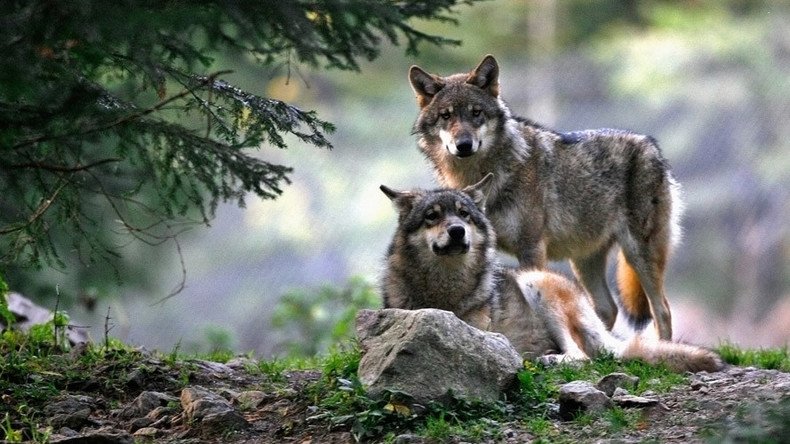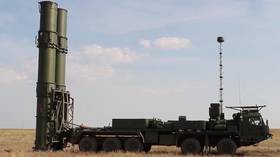16 wolves get death penalty for eating into Wyoming cattle rancher profits

Sixteen wild grey wolves in the US state of Wyoming have been sentenced to death by humans for preying on their cattle, according to a new order from the Fish and Wildlife Service.
Eleven have been slaughtered so far with guns fired from a helicopter after one wolf pack had ‘beef for dinner’ at least 10 times over the winter months and another killed 19 elk and 19 cows.
Wolves Slaughter 19 #Wyoming Elk in a Single Night https://t.co/P0p7wHvRiK#ElkHunting#Conservationpic.twitter.com/GvyKrC3W34
— SportingClassics Mag (@SportingClassic) March 30, 2016
US policy driven by the powerful rancher lobby spending millions of dollars every year means a violent end for the genetic link to man’s best friend, even though there's a debate as to whether wolves keep cattle herds healthier by culling out the weak links that are slow and dumb enough to be eaten.
Popular Science magazine, in an article titled Stop Shooting Wolves, You Maniacs, cited 2010 US Department of Agriculture figures that show they were one of the least deadliest predators for cattle, killing 8,100. In comparison, the wily coyotes successfully dropped their Acme anvils on 116,700, dogs 21,800, big cats 18,900, and vultures 11,900.
I want to drop a Wile E. Coyote - like anvil on self absorbed peoples heads. pic.twitter.com/HTTrA82SOp
— Myles Gregory UNLTD. (@MylesGregory) August 27, 2015
Wolves can be hunted by civilians in neighboring states, and were allowed to be killed by hunters or ranchers in Wyoming between 2012 and 2014, before being brought back under the control of federal authorities.
A pack of wolves killed 19 elk in western Wyoming, according to state wildlife officials describing the slaughter as an extremely rare
— Pearlie Kelker (@cilkalehming) April 3, 2016
“They’ve expanded into some of these marginal areas that are on the interface, if you will, between forest and ranchland,” US Fish and Wildlife wolf coordinator Mike Jimenez told Wyoming Public Radio. “Those kind of areas are not suitable for wolves.”
The five remaining wolves on the lam have used their legendary instincts to avoid their untimely deaths, including the detection of those noisy ‘birds’ flying overhead.
“A plane comes over and wolves pick that up and are aware of that and if they’re not in the trees, they head for the trees,” Jimenez explained.
If this persists, Jimenez says they can also resort to using ground-level traps, calls, and guns.
More than 11k Norwegians register to hunt… 16 wolves https://t.co/kf1T21P6a0pic.twitter.com/0xevB7PAB4
— RT (@RT_com) December 2, 2015
There was an increase in Wyoming’s wolf population last year with 382 included in the Northern Rocky Mountain Wolf Recovery Program 2015 Interagency Annual Report, up from 333 individuals in 2014.
A total of 84 wolves died in Wyoming in 2015, 54 from “control methods”, eight from “miscellaneous human causes”, 11 from natural causes, and another 11 from “unknown causes.”
The bodies of the dead wolves are donated to research organizations.
Wild #wolf caught on camera for 1st time in #Sweden (VIDEO) https://t.co/BOG6bJPDZRpic.twitter.com/vRPNAtjYfx
— RT (@RT_com) February 29, 2016
The government’s intervention has been criticized with some groups branding the Fish and Wildlife Service as the “Big Bad Ranchers’ little b*tch” and questioning whether it is the wolves carrying out all the attacks.
Good citizens of #Wisconsin, #Minnesota, #Michigan, #Wyoming and nationwide, #wolves need your help! 🐕 https://t.co/51Fmt8lJqw
— WolfNW (@WolfNW) April 16, 2016
Former Vice Presidential candidate Sarah Palin famously called for an increase in wolf hunting in Alaska, which she said it was vital for maintaining healthy populations.
As governor, Palin gave the all clear for wolves to be shot from helicopters and also "authorized managers to gas wolf pups in their dens," reported Audubon Magazine.
Alaska also paid aerial gunners $150 in cash for turning in legs of freshly killed wolves, according to NBC News.
Wolves. I love them as the spirit of the wild. pic.twitter.com/eBUA4jNCon
— Gail Kristin Upp (@GailUpp) April 27, 2016












